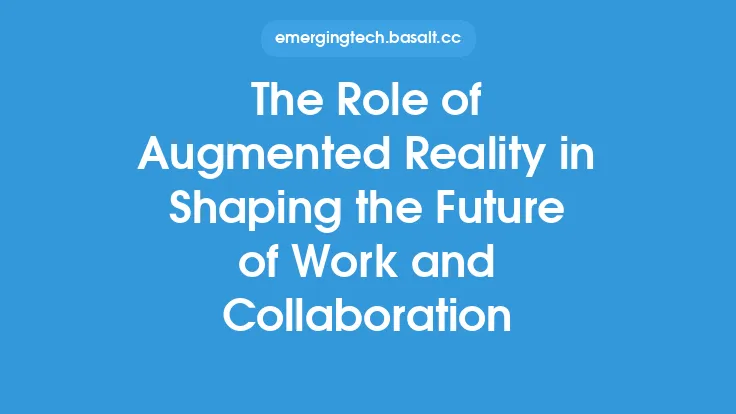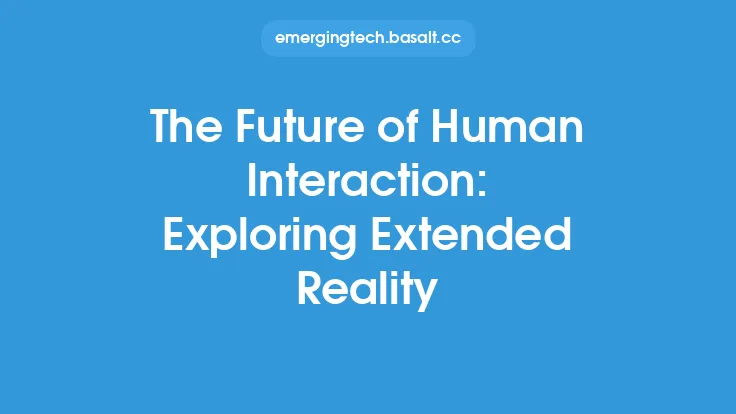The concept of Extended Reality (XR) has been gaining significant attention in recent years, and its potential to shape the future of work and entertainment is vast. XR is an umbrella term that encompasses Virtual Reality (VR), Augmented Reality (AR), and Mixed Reality (MR), which are transforming the way we interact with information, each other, and the world around us. As XR technology continues to evolve, it is likely to have a profound impact on various aspects of our lives, from the way we work and learn to the way we entertain ourselves.
Introduction to Extended Reality
Extended Reality is a term used to describe the spectrum of technologies that extend our reality by blending the physical and digital worlds. It includes Virtual Reality (VR), which creates a completely artificial environment; Augmented Reality (AR), which overlays digital information onto the real world; and Mixed Reality (MR), which combines elements of both VR and AR to create a hybrid experience. XR technology has the potential to revolutionize numerous industries, including education, healthcare, entertainment, and manufacturing, by providing immersive, interactive, and engaging experiences.
The Impact of Extended Reality on Work
The impact of XR on the future of work is significant, and it is likely to change the way we collaborate, communicate, and learn. With XR, remote workers can participate in virtual meetings and collaborate with colleagues in a more immersive and engaging way. XR can also enhance training and development programs by providing interactive and experiential learning experiences. For example, medical students can use XR to practice surgeries in a simulated environment, while engineers can use XR to design and test complex systems. Additionally, XR can improve productivity and efficiency by providing workers with real-time information and guidance, enabling them to make better decisions and complete tasks more quickly.
The Role of Extended Reality in Entertainment
XR is also poised to revolutionize the entertainment industry by providing new and innovative ways to experience music, movies, and games. With XR, audiences can immerse themselves in virtual worlds, interact with characters and objects, and experience stories in a more engaging and interactive way. For example, XR can enable viewers to step into the world of a movie or TV show, exploring virtual sets and interacting with virtual characters. XR can also enhance the gaming experience by providing players with a more immersive and interactive environment, where they can engage with virtual objects and characters in a more realistic way.
Technical Aspects of Extended Reality
From a technical perspective, XR relies on a range of technologies, including displays, sensors, and software. XR devices, such as head-mounted displays (HMDs) and smart glasses, use displays to project digital information onto the real world. Sensors, such as cameras and accelerometers, track the user's movements and gestures, enabling them to interact with virtual objects and environments. Software, such as game engines and XR platforms, provide the tools and frameworks needed to create XR experiences. Additionally, XR relies on advanced technologies, such as artificial intelligence (AI) and machine learning (ML), to enable more sophisticated and interactive experiences.
Applications of Extended Reality
The applications of XR are diverse and widespread, and they include education, healthcare, entertainment, and manufacturing. In education, XR can provide interactive and experiential learning experiences, enabling students to engage with complex concepts and ideas in a more immersive and engaging way. In healthcare, XR can be used to train medical professionals, provide therapy and treatment, and enhance patient outcomes. In entertainment, XR can provide new and innovative ways to experience music, movies, and games. In manufacturing, XR can improve productivity and efficiency by providing workers with real-time information and guidance, enabling them to make better decisions and complete tasks more quickly.
Challenges and Limitations of Extended Reality
Despite the potential of XR, there are several challenges and limitations that need to be addressed. One of the main challenges is the cost and accessibility of XR technology, which can be prohibitively expensive for many individuals and organizations. Another challenge is the need for high-quality content and experiences, which can be difficult to create and distribute. Additionally, XR raises several ethical and social concerns, such as the potential for addiction, social isolation, and decreased attention span. Furthermore, XR technology is still in its early stages, and there are several technical challenges that need to be addressed, such as latency, resolution, and field of view.
Future of Extended Reality
The future of XR is exciting and uncertain, and it is likely to be shaped by advances in technology, changes in consumer behavior, and the development of new applications and use cases. As XR technology continues to evolve, we can expect to see more sophisticated and interactive experiences, enabled by advances in AI, ML, and other technologies. We can also expect to see more widespread adoption of XR, as the cost and accessibility of XR technology decrease and the benefits of XR become more widely recognized. Additionally, we can expect to see new and innovative applications of XR, such as the use of XR in therapy and treatment, the development of XR-based education and training programs, and the creation of new forms of XR-based entertainment and storytelling.





